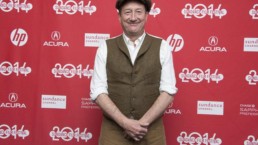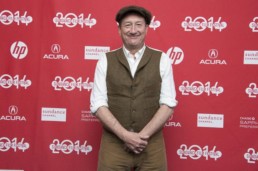Director Steven Knight on ‘Locke’
"As you write a film you always have the film in your head, beginning to end, edited perfectly... Locke is as close as I've ever got to a film being exactly how I imagined it."
“It’s really funny, I’m just seeing the construction site and the concrete delivery…” “Haha, if only we had done the L.A. Times photo in front of that…”
I look behind me from the 10th floor of the Ginsberg Libby office to see, in fact, a giant construction site on Hollywood Blvd. It’s quite fitting; I just finished talking to Steven Knight, director of the dramatic thriller Locke, in which ordinary man Ivan Locke is confronted with life-altering decisions in a single night. Locke is a blue-collar family man, working as a concrete supervisor on construction sites (cue the irony) when he receives a phone call that will change his life forever. In this mesmerizing film, which only focuses on one character in one location, the role of the director is magnified, and so it was my pleasure to sit down with Steven and talk about working with Tom Hardy, his directorial style and the “anti-film” that is Locke. We begin:
THE ONE THING THAT STUCK OUT TO ME IS THAT THIS FILM IS DESCRIBED AS AN “ANTI-FILM,” DO YOU LIKE THAT?
It’s not that it’s an “anti-film,” it’s just different. The thing about this film is that people are invited to use their imagination. One of the best comments is when people come out and they forget they haven’t seen the other characters because they sort of made them up, and I feel that with technology and budgets, it is possible to put the imagination on the screen. It’s someone else’s imagination, but it’s all there. With a film like this you have to sort of work at it because you’re not given anything other than the interior of the car and one person. With Locke, I didn’t want to make an art-house, experimental film that would only appeal to a particular audience, but a film that would appeal to everyone that’s made in a different way. Often “experimental” means a particular sort of audience, that only those people are intelligent enough to “get” experimental, and that’s not true.
THE IDEA FOR LOCKE CAME FROM YOUR PREVIOUS FILMS’ CAMERA TESTS ON THE ALEXA CAMERA, DID YOU END UP SHOOTING ON AN ALEXA?
No we shot on a RED at the end…it was smaller so we had more room in the car. The director of photography used a RED on cars at night before and they’re very good, just brilliant.
YOU COULD PRACTICALLY SEE SHADOWS IN THE DARK…
Oh you can shoot starlight. When I was looking at the tests they were so beautiful. Even as we shot this I wanted it to be that you could turn the sound down and show it at a bar or a club or whatever and people would look and be intrigued by it.
ANY SCREENSHOT LOOKS LIKE A PIECE OF ART, IT’S AMAZING.
Yeah!
IN CASTING THE LEADING MAN, TOM HARDY, DID YOU HAVE SPECIFIC CRITERIA YOU WERE LOOKING FOR OR DID HE BLOW YOU AWAY UNEXPECTEDLY?
This film came together as a series of happy accidents, really. I was meeting Tom about something else and just thought if you’re going to have someone on screen for that long you better be really good and I think he’s the best actor. I put to him the idea before writing the script and he was really intrigued. I wrote the script with him in mind knowing that he’d be able to pull it off and then we were shooting within a couple weeks.
IN A MOVIE LIKE THIS, A LOT OF IT DEPENDS OBVIOUSLY ON THE ACTOR, BUT ALSO THE DIRECTION BECAUSE YOU CAN’T HIDE BEHIND MUCH…
Exactly, yeah.
WHAT DIRECTIONS DID YOU GIVE TOM? DID HE CREATE IVAN?
The script remained exactly the same, word for word, because he likes to work off the page which is great. We sat round a table for five days and went through the script with the other actors so any sort of direction, we could deal with then. The beard was his, the clothes were his, the Welsh accent was [inspired by] somebody he knew. Tom said ‘This is the first straight role I’ve ever done.’ You know? He’s not a monster, he’s not a madman… the point of the whole [film] is to take an ordinary man with a wife and two kids who works in construction and then see if that can sustain onscreen. It’s an ordinary tragedy.
DID YOU HAVE ANY CONCERNS ABOUT MAKING A FILM THAT WAS SET IN “REAL TIME”?
No, not really. There’s always the practical and logical reason not to do the obvious thing when you’re making a film. There’s always someone that comes along and says ‘no you can’t do that.’ But with this, because I wanted it to be like a play, the most logical way to do it is to get three cameras rolling and then I say “action” once and we set off. The other actors were in a conference room in a hotel with a real phone line into the car, so the calls are all real. I would cue the first call, second call and we’d shoot it beginning to end all the way through. The only times we pulled over is because the RED has a memory card of about 30 minutes, so every 27 minutes we’d pull over, change the memory card, change the lens, change the angle and leave Tom alone so that he’s still in character. We had 16 movies at the end.
WOW, SO WAS THE EDITOR IN HEAVEN OR PULLING HER HAIR OUT?
Haha, no it was great.
AT THE END OF THE DAY WAS THE FINISHED PRODUCT EXACTLY AS YOU ENVISIONED IT?
That’s the thing, as you write a film you always have the film in your head, beginning to end and edited perfectly. When you go and make it in the real world things change… but with this, it’s as close as I’ve ever got to it being exactly how I imagined it.
AS A DIRECTOR, ARE THESE TYPES OF MOVIES WHAT YOU WANT TO BE REMEMBERED FOR?
Completely, completely. I’ll be doing another one at the start of next year which again will be quite experimental, with Helen Mirren. The Hundred Foot Journey has just been cut together and is looking fantastic.
Morgan Rojas
Certified fresh. For disclosure purposes, Morgan currently runs PR at PRETTYBIRD and Ventureland.



